This post is part of a blog collaboration on healthy comfort foods and recipes, as well as thoughts on comforts beyond the kitchen. Links to the other participants’ articles are below my recipe.
One of my first ‘blogging’ friends was the ever-lovely Katie Schmidt of Whole Nourishment. Although we’ve never actually met (being in opposite hemispheres), I’ve no doubt that Katie would be as warm and generous in person as she is online. Moreover, her blog is one of my favourite spots online – unpretentious and inviting, replete with thoughtful, delicious recipes that embrace whole foods and mindful eating. In particular, I appreciate the informed way Katie discusses nourishment in a holistic sense, and have learned a lot from her approach to integrating food and life. So, when Katie invited me to participate in a collaborative recipe series around comfort food, I jumped at the chance!
Katie invited myself and four other food bloggers to reflect on the notion of comfort, both in food and in life. In Katie’s words: “Comfort food to me is not only the food on my plate but also the non-food aspects of daily life that nourish me all the same.” These days, when people talk about comfort food what they usually mean is the kinds of sugary/oily/salty food that are too-often used as an emotional crutch. Which isn’t comfort, not really. Katie draws a whole different – and much refreshing – take on it, elucidating the ways that certain foods and the accompanying life choices bring our bodies a genuine deep-seated comfort.
So what does comfort food mean to me? The best way I can think to describe comfort food is as the things that bring me home. Not in the literal sense, in the soul sense. Yoga makes me feel energised, meditation brings me calm, a glass of wine mellows me. But I seek comfort in the simplest things, the familiar rituals that evoke warmth and safety and ease. For me, comfort is in re-reading favourite books that let my imagination soar, kissing my sleeping children on their flushed little cheeks, our family’s Saturday morning market ritual of coffee and croissants by the river, walking through a produce market anywhere in the world, stirring an early morning pot of porridge on the stove, pulling back the sheets and getting into bed with S at the end of the day. Comfort is in the little things that can be found anywhere and everywhere. I’ve always been a tea drinker, and the ritual of a cup of tea and a good book in the morning sunshine was as equally comforting with spiced chai on the streets of Rishikesh in India, as it is with green tea on my verandah in Brisbane.
And so the foods that bring me the most comfort are those that are imbued with these same feelings of contented familiarity, ritual, warmth. The things that bring us comfort are, I believe, deeply personal. So I won’t offer any firm comfort food suggestions. Rather, I will offer this. Think about what home means for you – what draws your soul to its anchor point. Find the things that get you there and take the time to notice them, to appreciate them, to let them settle into your bones. These are your comfort foods.
When Katie asked me to share a recipe that, for me, epitomised comfort food, I knew straight away what I was going to make. Over a decade ago now, I spent a year living in Buenos Aires. I was twenty-one years old, and in love with the world, with Argentina, with adventure. It was a wonderful year; I learned to speak a new language, I made new friends, I slept on beaches on the Caribbean coast of Colombia, I read countless books, I felt free and wild and beautiful. I didn’t get homesick, not really. But I did, on occasion, miss certain home comforts. At the top of my list was Vietnamese food. In particular, pho.
Pho has always been one of my very best meals. Whenever we go for Vietnamese I’ll look through the menu, but invariably order pho. When we were in Vietnam a few years ago the glut of amazing food was, well, amazing. And strolling past the streetside pho stalls everyday remains one of my food-travel highlights. One of the great advantages of growing up in a multi-cultural city like Melbourne was the food. As a family, we regularly ate Indian takeaway at home, Italian in Carlton, Vietnamese on Victoria St. The latter was always my favourite. Victoria St is lined with Vietnamese restaurants, but like most regulars, our family always went back to the same one. We ate crispy spring rolls wrapped in fresh crunchy lettuce, delicately spiced fried rice, steaming pots of jasmine tea, and deep bowls of aromatic noodle-laden pho.
And so still, to this day, no matter where I am or what is going on, pho brings me home. It is all the things that I want when I am looking for comfort. It is warming and simple, nourishing. It takes a while to prepare and this gives the cooking of it a sense of mindfulness. The toppings are personalised, and yet it is a meal that I usually share with my family. And frankly, it is really damn tasty.
Enjoy!
Sarah x
And don’t forget to scroll to the bottom of the recipe for the links to more comfort food recipes – all of them are definitely worth visiting!
Vegetarian Pho
This vegetarian pho broth is deeply spiced and yet much lighter than its meaty counterpart. It is as good in summer as in winter, and the toppings can be customised as you like. Below I’ve listed the veges and herbs that are traditionally served with pho (and that I always include), but you can also add things like thinly sliced tofu, bok choy, edamame. And whatever you do, make sure you use homemade stock – if you don’t have any, simply throw some carrots, leeks, celery, and corn into the broth to deepen the flavour.
Ingredients
Broth
2 brown onions
80 grams ginger, peeled
3 stalks lemongrass, trimmed and sliced
40 grams shitake mushrooms (approx. 15 – 20)
6 star anise
2 – 3 sticks cassia bark (or cinnamon sticks)
6 cloves
1 tbsp peppercorns
1 tbsp sugar
1 tbsp tamari or soy sauce
3 litres vegetable stock, homemade
Salt, to taste
Toppings, to serve
Rice noodles
Lime
Spring onion
Red chilli
Bean shoots
Coriander
Vietnamese basil
Vietnamese mint
Method
Peel and quarter the onions. Peel and thickly slice the ginger. Scorch the onion and ginger, either by holding them over a flame with tongs or, if you’re using an electric stove, in a dry pan. Scorch until the onion and ginger are blackened in parts.
In a large heavy-bottomed pot combine the scorched onion and ginger, the sliced lemongrass, the shitake, all of the spices, the sugar, and ll of the stock. Bring to a boil then lower to a barely-there-simmer. Continue to simmer for an hour, then add the tamari and salt, to taste. Simmer for another 15 – 20 minutes, then remove from the heat. Give it a taste and, if you like, add a touch more tamari and/or salt.
Before you serve the soup, prep all of the toppings. Cook the rice noodles according to packet instructions until al dente, then divide between four bowls. Slice the lime into quarters and thinly slice both the chilli and the spring onion. Wash the bean shoots and the herbs. Put all of the toppings onto plates or bowls so that everyone can help themselves, according to personal taste.
Strain the soup, reserving the liquid and the shitake mushrooms. Divide equally between the four bowls over the rice noodles. Serve while hot, inviting everyone to generously top their bowls with all of the trimmings.
Serves: 4
—
For some more ideas on finding and making comfort food visit:
Cinnamon Hot Chocolate | Whole Nourishment
Thai Red Curry with Tofu | Orchard Street Kitchen
Self-Saucing Cheese & Roasted Vegetable Pasta Bake | Food to Glow

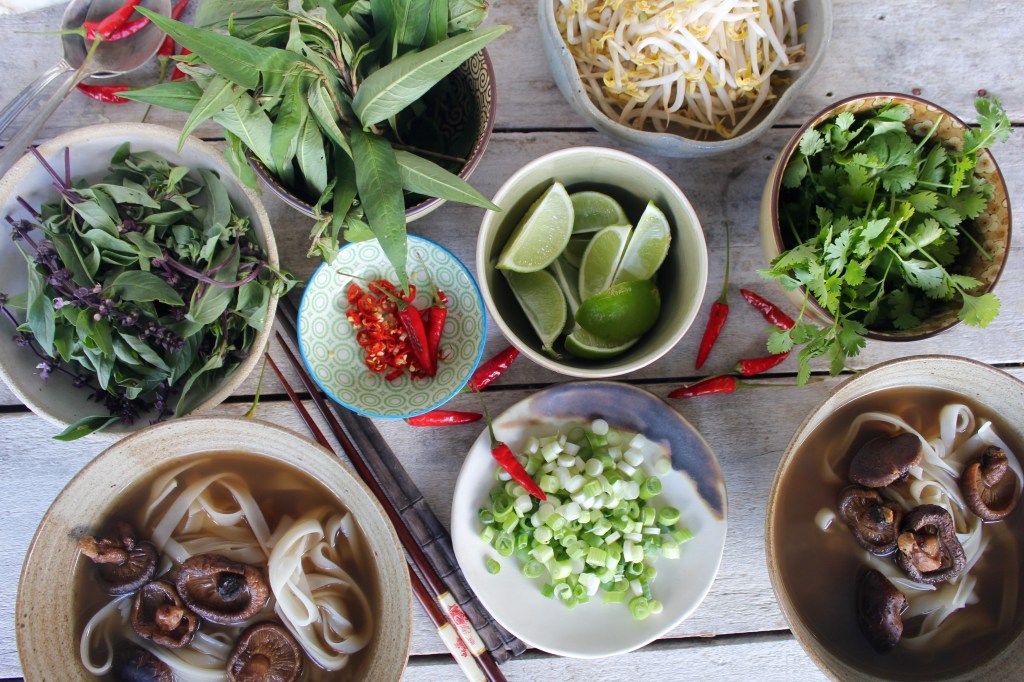

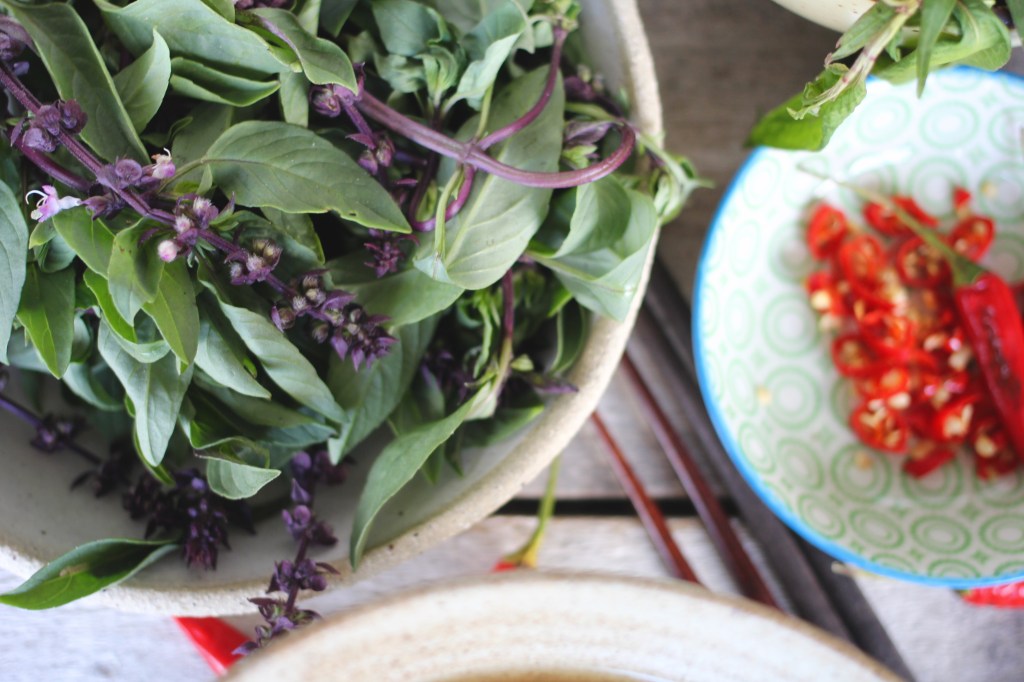
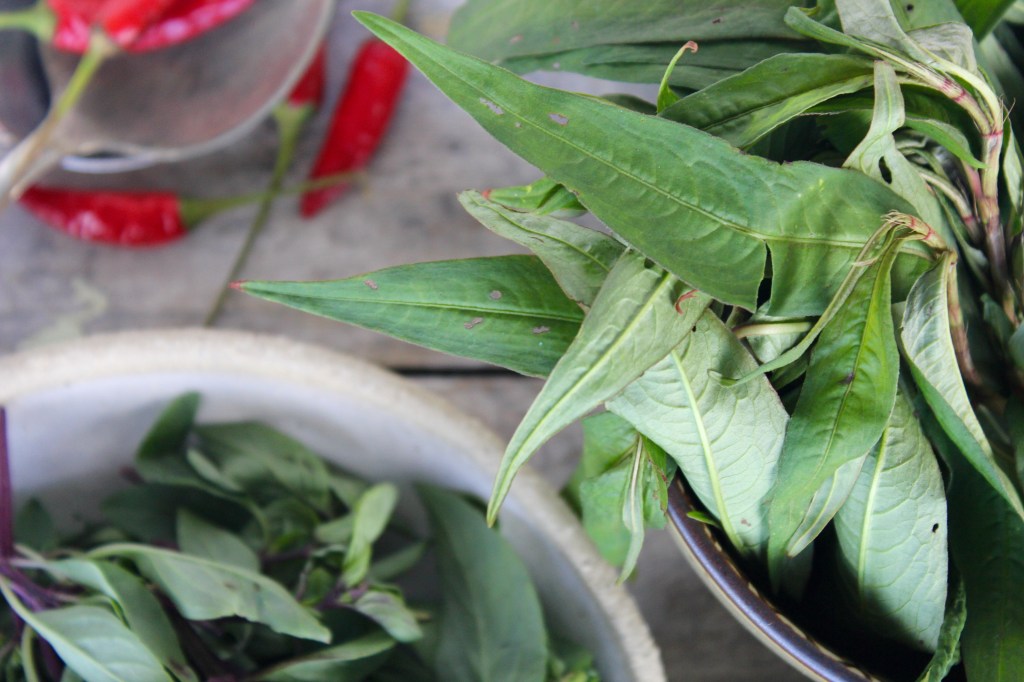


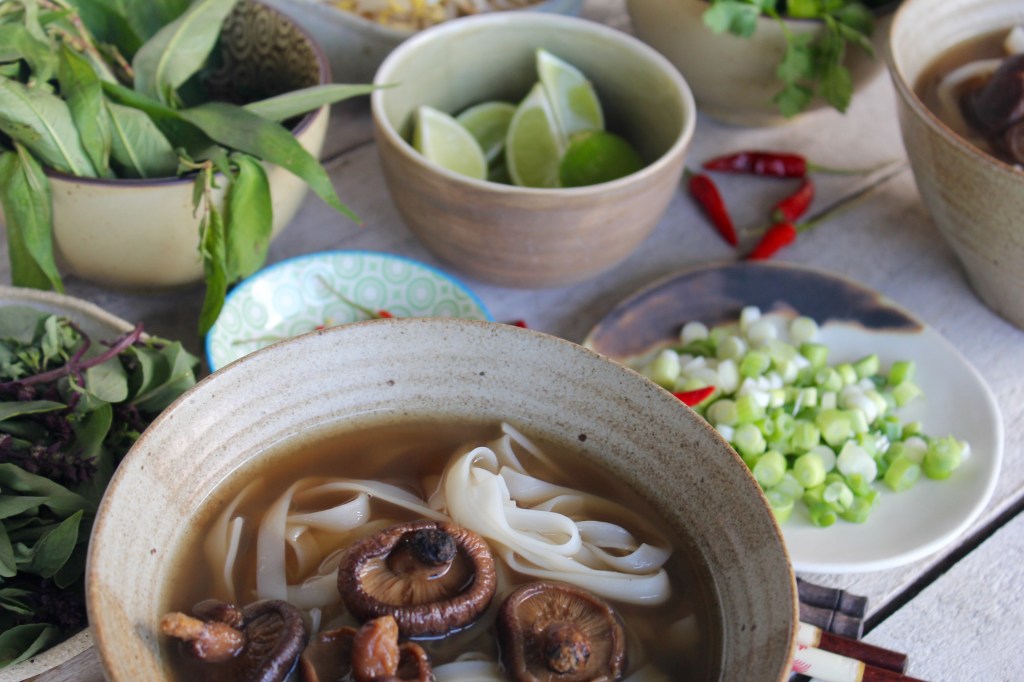
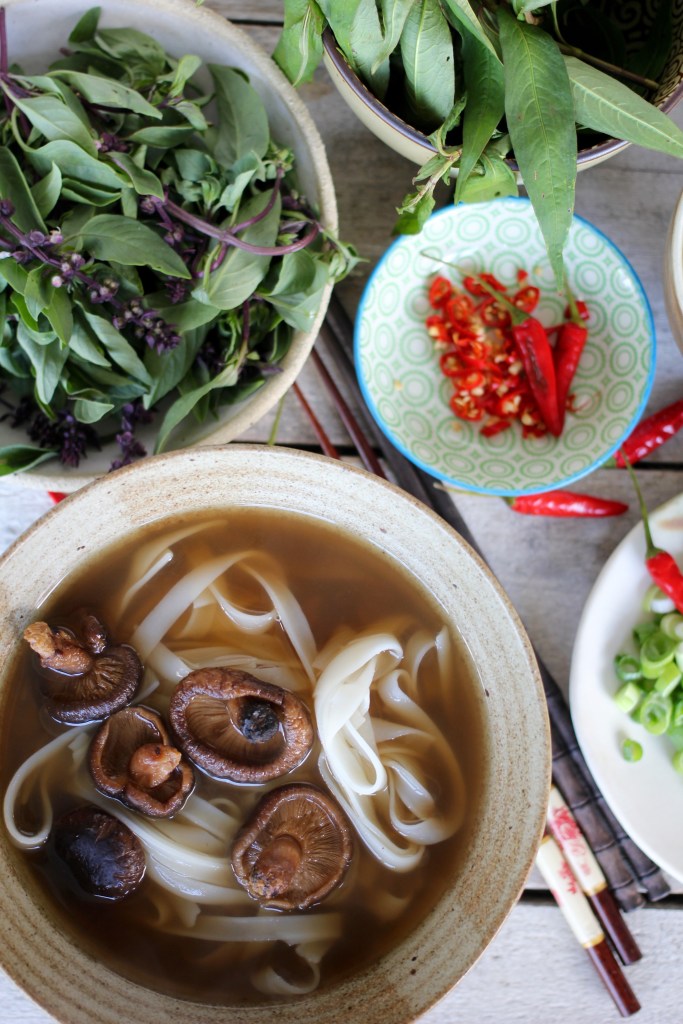
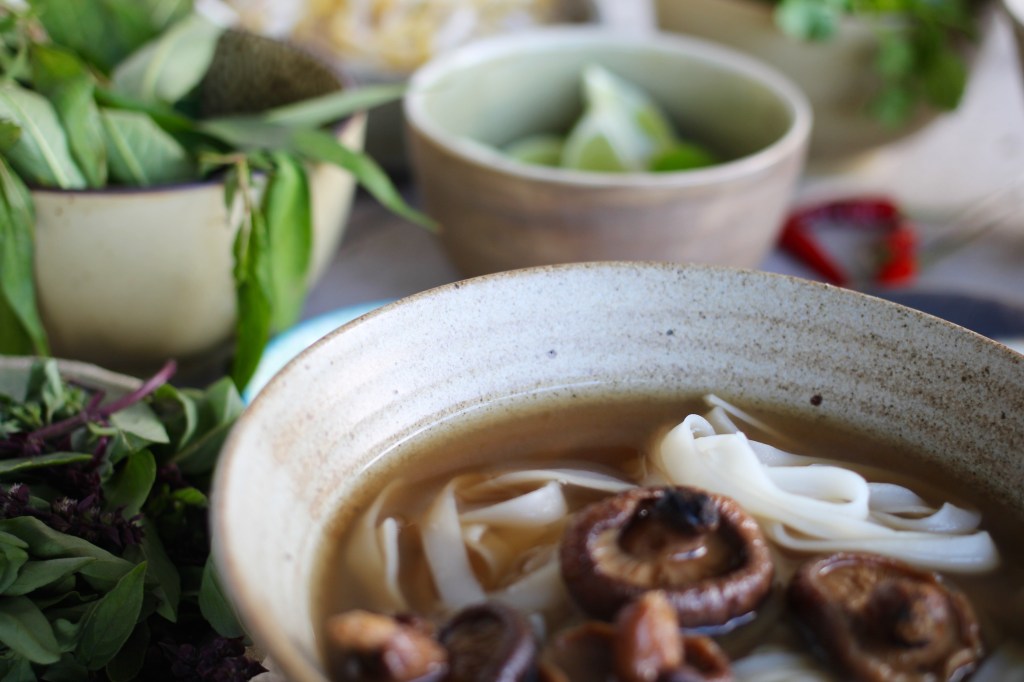
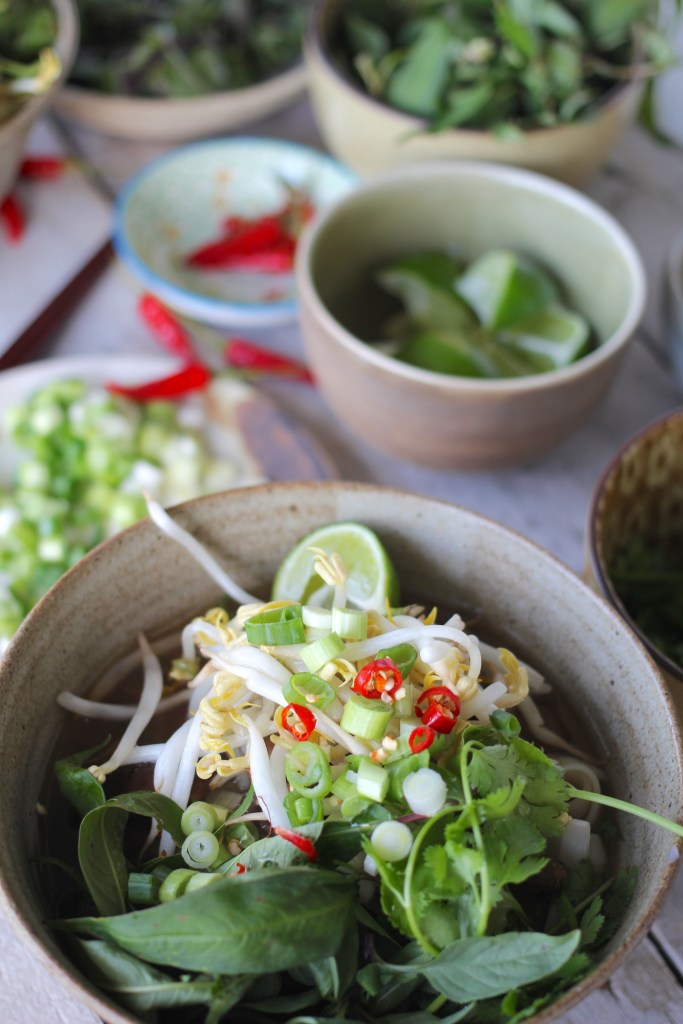


Looks delicious! I was just craving pho yesterday 🙂
Sometimes I feel like I’m in a perpetual state of pho-craving!
Oh, I totally know that feeling–especially when it’s really cold outside!
Living in a tropical climate means I need to get my soup on even when it’s hot!
Sarah, what an incredibly beautiful post. You have expressed comfort in such a genuine but eloquent way that it gave me chills. All of it I relate to yet I could not have said it near as well myself. It was an honor to have you participate. I do hope everyone takes time to read all of our thoughts – reading them myself has given me one of the most refreshing starts to the week that I very much needed. Thank you again!! Noodle bowls are of my comforts as well and I will definitely be trying this one.
Thanks so much Katie. And thanks for inviting me to be a part of this series. Even though I knew what I wanted to cook as my comfort food straight away, I spent a good bit of time thinking about the notion of comfort and loved being prompted to reflect on something I hadn’t previously thought about all that much. In the end this turned out to be one of my favourite posts to craft – to write, to photograph, and of course to eat. I’m really looking forward to reading everyone else’s posts – particularly yours!
This makes me so happy to hear Sarah. This was probably my favorite post of yours as well. You have a great way of putting emotions into words – not easy.
Pho is our favorite soup on chilly nights! I’ve been looking for a recipe that would be authentic, but doable, and this fits the bill. I will add this to my list of things to make. Also, such a lovely post. “Comfort food” is a phrase used often in our house.
Thanks Jasmine! Let me know how the pho goes when you make it.
Will do!!
How cool that you lived in Buenos Aires! My husband is half Argentine and lived there as a child. I finally got to go last year and absolutely loved what I saw. I am itching to go back and explore more of the country! This pho looks absolutely delicious and comforting. I like how it comforts you because you associate it with happy memories – what a nice way to think of comfort food. I am definitely planning on making this soon!
I know, right?! Buenos Aires is one of my all time favourite places, cannot wait to go back again someday. And if you ever get the chance to go down to Tierra del Fuego, oh so beautiful.
Lovely post Sarah! I caught an unseasonal flu 10 days ago, and with my husband away I had to fend for myself. I crawled out of bed every second day to buy a massive serving of pho from the Vietnamese restaurant downstairs. I lived on it for four full days – comfort indeed (along with vegemite on wholegrain toast). Happy new year 🙂
Thanks Chez – and happy new year to you as well. Pho is the best cure for the flu, but I hope you’re feeling better now!
Much better, thank you 🙂
“What draws your soul to its anchor point.” What beautiful words, and indeed a gorgeous recipe.
Thanks kellie!